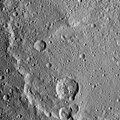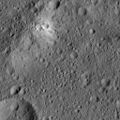Kerwan
Coordinates: 10 ° 46 ′ 12 ″ S , 123 ° 59 ′ 24 ″ E
| Kerwan Ceres Crater | |
|---|---|
|
Image of Kerwan crater from the Dawn spacecraft |
|
| properties | |
| width | 10.77 S |
| length | 123.99 O |
| diameter | 280 km |
| Namesake | Kerwan, spirit of the Hopi sprouting maize |
Kerwan is the largest impact crater on the dwarf planet Ceres . It was discovered on February 19, 2015 on images taken by the Dawn spacecraft as it approached Ceres. Its diameter is 280 kilometers.
The name comes from the spirit of the sprouting corn in the Hopi mythology and was officially confirmed by the IAU on July 3, 2015 .
description
Kerwan is located in the south of the Vendimia Planitia plain, with its northern half on the equator. Instead of a central mountain, the Insitor crater is located in its center. This has a diameter of 26 kilometers. Kerwan crater is the namesake of the cartographic Kerwan hemisphere of Ceres, the side piece to the Occator hemisphere.
The bottom of the impact basin is relatively flat and shows only a small amount of younger impact craters. The area around the pelvis also appears smoother and less cratered than the rest of the Ceres surface. The reason for this is a long-term, compensating plastic deformation of the Ceres crust or a rejuvenation of the relief due to possible geological processes in the interior of the Ceres.
gallery
Web links
Individual evidence
- ↑ Cerescrater in the Gazetteer of Planetary Nomenclature of the IAU (WGPSN) / USGS ; accessed on May 27, 2017.
- ↑ Thomas Roatsch: Ceres Nomenclature. (PDF) February 28, 2017, accessed May 27, 2017.
- ↑ Insitor in the Gazetteer of Planetary Nomenclature of the IAU (WGPSN) / USGS
- ^ Tilmann Althaus: The first atlas of Ceres is finished. November 26, 2015, accessed May 27, 2017 .
- ↑ Tilmann Althaus: In orbit around a dwarf planet. In: Stars and Space , May 2015, p. 37.




